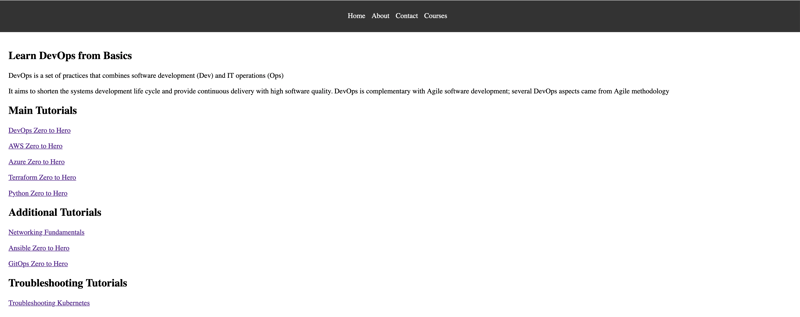在這篇文章中,我將引導您完成基於 Go 的 Web 應用程式的 DevOpsifying 流程。我們將涵蓋從使用 Docker 將應用程式容器化到使用 Helm 將其部署在 Kubernetes 叢集 (AWS EKS) 上、設定與 GitHub Actions 的持續整合以及使用 ArgoCD 自動化部署的所有內容。在本教程結束時,您將擁有一個完全可操作、支援 CI/CD 的 Go Web 應用程式。
在開始此專案之前,請確保您符合以下先決條件:
AWS 帳戶:您需要一個有效的 AWS 帳戶來建立和管理 EKS 集群,以部署基於 Go 的應用程式。
DockerHub 帳戶: 您應該有一個 DockerHub 帳戶來推送您的 Docker 映像。
基本 DevOps 知識:熟悉 DevOps 概念和實踐至關重要,包括了解 CI/CD 管道、容器化、編排和雲端部署。
Helm:打包和部署應用程式需要具備 Kubernetes 套件管理器 Helm 的基本知識。
透過滿足這些先決條件,您將做好充分準備按照本指南中的步驟進行操作,並成功對基於 Go 的應用程式進行 DevOpsify!
要開始使用該項目,您需要從 GitHub 儲存庫克隆原始程式碼。使用以下命令克隆項目:
git clone https://github.com/iam-veeramalla/go-web-app-devops.git
此儲存庫包含使用本指南中所述的 DevOps 實務設定和部署基於 Go 的應用程式所需的所有檔案和配置。複製後,您可以瀏覽以下步驟並依照這些步驟容器化、部署和管理應用程式。
第一步是容器化我們的 Go 應用程式。我們將使用多階段 Dockerfile 來建立 Go 應用程式並建立一個輕量級的生產就緒映像。
FROM golang:1.22.5 as build WORKDIR /app COPY go.mod . RUN go mod download COPY . . RUN go build -o main . FROM gcr.io/distroless/base WORKDIR /app COPY --from=build /app/main . COPY --from=build /app/static ./static EXPOSE 8080 CMD ["./main"]
建置與推送 Docker 映像的指令:
docker login docker build . -t go-web-app docker push go-web-app:latest
在此 Dockerfile 中,第一階段使用 Golang 映像來建置應用程式。第二階段使用 distroless 基礎鏡像,它更小、更安全,僅包含執行 Go 應用程式所需的檔案。
接下來,我們將把容器化應用程式部署到 Kubernetes 叢集。以下是如何設定叢集和部署應用程式。
建立 EKS 叢集:
eksctl create cluster --name demo-cluster --region us-east-1
部署配置(deployment.yaml):
apiVersion: apps/v1
kind: Deployment
metadata:
name: go-web-app
labels:
app: go-web-app
spec:
replicas: 1
selector:
matchLabels:
app: go-web-app
template:
metadata:
labels:
app: go-web-app
spec:
containers:
- name: go-web-app
image: iamamash/go-web-app:latest
ports:
- containerPort: 8080
服務配置(service.yaml):
apiVersion: v1
kind: Service
metadata:
name: go-web-app
labels:
app: go-web-app
spec:
ports:
- port: 80
targetPort: 8080
protocol: TCP
selector:
app: go-web-app
type: ClusterIP
入口配置(ingress.yaml):
apiVersion: networking.k8s.io/v1
kind: Ingress
metadata:
name: go-web-app
annotations:
nginx.ingress.kubernetes.io/rewrite-target: /
spec:
ingressClassName: nginx
rules:
- host: go-web-app.local
http:
paths:
- path: /
pathType: Prefix
backend:
service:
name: go-web-app
port:
number: 80
使用 kubectl 套用設定:
kubectl apply -f deployment.yaml kubectl apply -f service.yaml kubectl apply -f ingress.yaml
設定 Nginx Ingress 控制器:
Kubernetes 中的入口控制器管理對叢集內服務的外部訪問,通常處理 HTTP 和 HTTPS 流量。它提供集中式路由,讓您可以定義流量如何到達您的服務的規則。在這個專案中,我們使用 Nginx Ingress 控制器來有效管理流量並將流量路由到部署在 Kubernetes 叢集中的基於 Go 的應用程式。
kubectl apply -f https://raw.githubusercontent.com/kubernetes/ingress-nginx/controller-v1.11.1/deploy/static/provider/aws/deploy.yaml
為了更有效地管理我們的 Kubernetes 資源,我們使用 Helm(Kubernetes 的套件管理器)來打包我們的應用程式。
建立 Helm 圖表:
helm create go-web-app-chart
建立圖表後,用您的deployment.yaml、service.yaml 和 ingress.yaml 檔案取代 templates 目錄中的所有內容。
更新values.yaml:values.yaml 檔案將包含動態值,例如 Docker 映像標籤。標籤將根據 GitHub Actions 執行 ID 自動更新,確保每個部署都是唯一的。
# Default values for go-web-app-chart.
replicaCount: 1
image:
repository: iamamash/Go-Web-App
pullPolicy: IfNotPresent
tag: "10620920515" # Will be updated by CI/CD pipeline
ingress:
enabled: false
className: ""
annotations: {}
hosts:
- host: chart-example.local
paths:
- path: /
pathType: ImplementationSpecific
頭盔部署:
kubectl delete -f k8s/. helm install go-web-app helm/go-web-app-chart kubectl get all
為了自動建置和部署我們的應用程序,我們使用 GitHub Actions 設定了 CI/CD 管道。
GitHub Actions 工作流程 (.github/workflows/cicd.yaml):
name: CI/CD
on:
push:
branches:
- main
paths-ignore:
- 'helm/**'
- 'README.md'
jobs:
build:
runs-on: ubuntu-latest
steps:
- name: Checkout repository
uses: actions/checkout@v4
- name: Set up Go 1.22
uses: actions/setup-go@v2
with:
go-version: 1.22
- name: Build
run: go build -o go-web-app
- name: Test
run: go test ./...
push:
runs-on: ubuntu-latest
needs: build
steps:
- name: Checkout repository
uses: actions/checkout@v4
- name: Set up Docker Buildx
uses: docker/setup-buildx-action@v1
- name: Login to DockerHub
uses: docker/login-action@v3
with:
username: ${{ secrets.DOCKERHUB_USERNAME }}
password: ${{ secrets.DOCKERHUB_TOKEN }}
- name: Build and Push action
uses: docker/build-push-action@v6
with:
context: .
file: ./Dockerfile
push: true
tags: ${{ secrets.DOCKERHUB_USERNAME }}/go-web-app:${{github.run_id}}
update-newtag-in-helm-chart:
runs-on: ubuntu-latest
needs: push
steps:
- name: Checkout repository
uses: actions/checkout@v4
with:
token: ${{ secrets.TOKEN }}
- name: Update tag in Helm chart
run: |
sed -i 's/tag: .*/tag: "${{github.run_id}}"/' helm/go-web-app-chart/values.yaml
- name: Commit and push changes
run: |
git config --global user.email "ansari2002ksp@gmail.com"
git config --global user.name "Amash Ansari"
git add helm/go-web-app-chart/values.yaml
git commit -m "Updated tag in Helm chart"
git push
To securely store sensitive information like DockerHub credentials and Personal Access Tokens (PAT) in GitHub, you can use GitHub Secrets. To create a secret, navigate to your repository on GitHub, go to Settings > Secrets and variables > Actions > New repository secret. Here, you can add secrets like DOCKERHUB_USERNAME, DOCKERHUB_TOKEN, and TOKEN. Once added, these secrets can be accessed in your GitHub Actions workflows using ${{ secrets.SECRET_NAME }} syntax, ensuring that your sensitive data is securely managed during the CI/CD process.
Finally, we implement continuous deployment using ArgoCD to automatically deploy the application whenever changes are pushed.
Install ArgoCD:
kubectl create namespace argocd
kubectl apply -n argocd -f https://raw.githubusercontent.com/argoproj/argo-cd/stable/manifests/install.yaml
kubectl patch svc argocd-server -n argocd -p '{"spec": {"type": "LoadBalancer"}}'
kubectl get svc argocd-server -n argocd
Setup ArgoCD Project: To access the ArgoCD UI after setting it up, you first need to determine the external IP of the node where ArgoCD is running. You can obtain this by running the command:
kubectl get nodes -o wide
Next, get the port number at which the ArgoCD server is running using:
kubectl get svc argocd-server -n argocd
Once you have the external IP and port number, you can access the ArgoCD UI by navigating to http://
To log in to the ArgoCD UI for the first time, use the default username admin. The password can be retrieved from the ArgoCD secrets using:
kubectl edit secret argocd-initial-admin-secret -n argocd
Copy the encoded password from the data.password field and decode it using base64:
echo <encoded-password> | base64 --decode
For example, if the encoded password is kjasdfbSNLnlkaW==, decoding it with:
echo kjasdfbSNLnlkaW== | base64 --decode
will provide the actual password. Be sure to exclude any trailing % symbol from the decoded output when using the password to log in.
Now, after accessing the ArgoCD UI, since both ArgoCD and the application are in the same cluster, you can create a project. To do this, click on the "New App" button and fill in the required fields, such as:
After filling in these details, click on "Create" and wait for ArgoCD to create the project. ArgoCD will pick up the Helm chart and deploy the application to the Kubernetes cluster for you. You can verify the deployment using:
kubectl get all
That's all you need to do!
Congratulations! You have successfully DevOpsified your Go web application. This end-to-end guide covered containerizing your application with Docker, deploying it with Kubernetes and Helm, automating builds with GitHub Actions, and setting up continuous deployments with ArgoCD. You are now ready to manage your Go application with full CI/CD capabilities.

Feel free to leave your comments and feedback below! Happy DevOpsifying!
For a detailed video guide on deploying Go applications on AWS EKS, check out this video.
以上是DevOpsifying Go Web 應用程式:端到端指南的詳細內容。更多資訊請關注PHP中文網其他相關文章!




